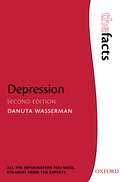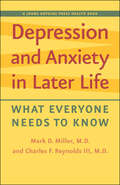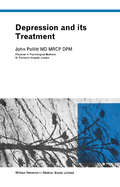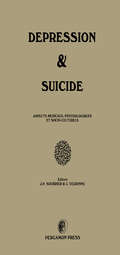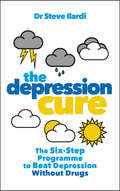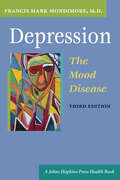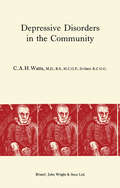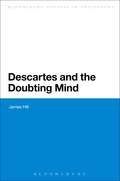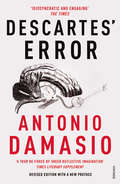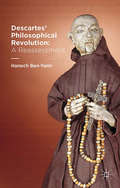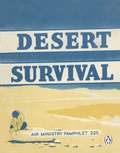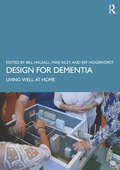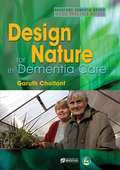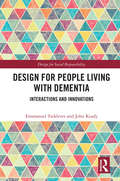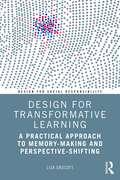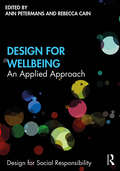- Table View
- List View
Depression (The Facts)
by Danuta WassermanThe term "depression" covers a wide spectrum of conditions ranging from mild despondency to melancholia, the very deepest form of depression. Natural despondency is not a disease but simply a part of life. Depression, however, is a common psychiatric illness that must be identified and treated in the same manner as other illnesses. Depression: The Facts, Second Edition provides a simple, yet comprehensive overview of depression for sufferers, their friends, and families. It contains case-study descriptions and can serve as a quick-reference for those with a medical background. It succinctly details the signs and symptoms of clinical depression, as well as the process of diagnosis and the different subtypes, including major depression, dysthymia, manic depression disorders, and seasonal affective disorder. The second part of the book covers the current understanding of the causes of depression, based on the scientific evidence. The book concludes with a review of treatment options and practical guidance on self-help in depression, as well as useful advice for family and friends. The main aim of this book is to reach those who need help and want to understand themselves and their condition more, in an easy-to-read format without an excess of medical terminology and statistics that may overwhelm the non-medically trained individual. All concepts have been broken down into bullet-points and sub-headings, to allow easy digestion of the concepts and information. This empowers the reader, and may ultimately prompt someone to seek help and support.
Depression and Anxiety in Later Life: What Everyone Needs to Know (A Johns Hopkins Press Health Book)
by Mark D. Miller Charles F. Reynolds IIIPhysical problems and emotional stresses, such as bereavement, health conditions, pain, concerns about the future, side effects of medications, and the accumulated effects of lifestyle choices, may lead to depression or anxiety in older people. However, as Drs. Mark D. Miller and Charles F. Reynolds III know, these mental disorders are not a natural or an inevitable part of aging. In Depression and Anxiety in Later Life, these psychiatrists show how depression and anxiety can be avoided or minimized by adapting to changing circumstances while controlling risk factors and getting help when it's needed.This reassuring book balances discussions of the causes, symptoms, and treatments of mental illness with descriptions of successful adaptive aging. Case studies illustrate the less obvious depression symptoms of irritability, disorganization, and social withdrawal. Readers will find information about memory loss, pain, sleep, nutrition, and end-of-life issues particularly helpful.Aging can be challenging, but it doesn’t always lead to depression or anxiety. Depression and Anxiety in Later Life will help older people, their family members, and caregivers make positive changes to take control of their own individual situations.
Depression and Its Treatment
by John PollittDepression and its Treatment focuses on medical interventions in the diagnosis and treatment of depression, as well as identification of symptoms and possible mechanisms of treatment. The book first offers information on the concept and classification of depression, physiology and psychopathology, and clinical types of depression, including classification of depressive illnesses and etiology. The publication then takes a look at the treatment of psychological and physiological depression and complications of depression and their treatment. The text ponders on the prognosis of psychological and physiological depression and critique of existing terminology, as well as illustrative case histories of depression. The manuscript is highly recommended for clinicians and psychiatrists wanting to explore the approaches in the treatment of depression.
Depression and Suicide: Aspects Medicaux, Psychologiques et Socio-Culturels
by J. P. Soubrier J. VedrinneDepression and Suicide: Aspects, Medicaux, Psychologiques, ET Socio-Culturels covers the proceedings of the 11th Congress of the International Association for Suicide Prevention, held in Paris, France on July 1981. This book is organized into four parts encompassing 132 chapters.Part I deals with the epidemiological studies and transcultural aspect of depression and suicide. This part discusses the influence of sociocultural and environmental factors in depressive and suicidal behavior. Parts II and III explore the theories and clinical approaches in depression and suicide, especially among young people. These parts consider the biological and medical aspects, hospital settings, and survivors of depression and suicide. Part IV emphasizes the therapeutics, crisis interventions, and paraclinical investigations of these neurological problems. This book will be of value to physicians, psychologists, psychiatrists, and researchers.
The Depression Cure: The Six-Step Programme to Beat Depression Without Drugs
by Dr Steve IlardiBased on extensive research with an amazing success rate, The Depression Cure outlines a step-by-step plan for recovery from depression, which focuses on six key lifestyle elements that have largely disappeared in healthy doses from modern life:- physical exercise - omega-3 fatty acids- natural sunlight exposure - restorative sleep- social connectedness- meaningful, engaging activityWith his six-step programme, Dr Ilardi not only makes sense of depression but offers a practical and straightforward plan for recovery. The Depression Cure is an essential guide for anyone seeking an alternative approach to depression treatment.
Depression, the Mood Disease: The Mood Disease (A Johns Hopkins Press Health Book)
by Francis Mark MondimoreDepression is a mood disorder that affects one in ten Americans in any given year. At one time too stigmatized to be mentioned in polite conversation, depression is now discussed frankly in the media, and advertisements for drug therapy appear everywhere. The third edition of this widely acclaimed book reflects changes in how mood disorders are thought about, and how they are treated. Dr. Francis Mark Mondimore, author of the best-selling book Bipolar Disorder: A Guide for Patients and Families, here explains depression—its causes and symptoms, and its treatment. He discusses depression in all age groups and in both sexes, as well as bipolar disorder, seasonal affective disorders, and depression that accompanies illness. This edition encompasses more than a decade of new research, advances in pharmacology, and changes in public perception. The past ten years have seen the release of new forms of the major antidepressants as well as other promising new avenues in pharmaceutical treatments. For example "atypical" or "second generation" antidepressants, such as venlafaxine and duloxetine, provide different ways of manipulating the chemical systems in the brain concerned with mood. And there have been significant advances in the use of MAO inhibitors, now available in patch form. Dr. Mondimore reviews these and other pharmacological therapies as part of a comprehensive approach to treatment that includes psychotherapy, family and community support, and lifestyle changes. Full of information compassionately presented, this guide provides hope and help to patients and their families.
Depressive Disorders in the Community
by C. A. WattsDepressive Disorders in the Community describes the diagnosis and treatment techniques of 60 case histories of depressive disorders. These cases are collected by one family doctor over a period of some sixteen years, in a single rural community. This book is composed of 10 chapters, and begins with studies of the nature of depressive illnesses and the controversial issue of the number of depressed persons in the community. The subsequent chapters describe the clinical symptoms and manifestations, as well as long-term observation of endogenous depression cases. These topics are followed by discussions on the clinical manifestations of patients with suicidal tendency. The concluding chapters focus on the treatment options of depressive patients, along with an overview of the social problem of depression. This book will be of great value to psychiatrists, general medical practitioners, and social workers.
Der Physikalismus als Lösung des Bewusstseinsproblems
by Markus GoleWir wissen, wie es ist, Schmerzen zu haben, jemanden zu lieben oder Angst zu haben. Diese subjektiven Erlebnisqualitäten werden "Qualia" (Singular: Quale) genannt und die Frage nach deren Platz in einer objektiven, naturwissenschaftlich geprägten Welt stellt das Bewusstseinsproblem dar. Eine Lösung ist die These des Physikalismus, die behauptet, dass alles Existierende physikalisch sei. Das Ziel der vorliegenden Arbeit ist es, die These des Physikalismus zu explizieren und zu zeigen, dass die hier erarbeitete Version auch wahr ist. Schließlich wird durch ein neues Argument gezeigt, dass die Wahrheit des Physikalismus deduktiv aus dessen Prämissen folgt. Der Physikalismus setzt sich somit innerhalb der Philosophie des Geistes als die überzeugendste Lösung des Bewusstseinsproblems durch.
Der Wille zur Herrschaft und der Hunger nach Glück: Max Webers Werk aus der Sicht der Kritischen Theorie (Beiträge zur sozialwissenschaftlichen Forschung #93)
by Brigitte HommerichDescartes and the Doubting Mind (Continuum Studies in Philosophy)
by James HillDescartes' characterisation of the mind as a 'thinking thing' marks the beginning of modern philosophy of mind. It is also the point of departure for Descartes' own system in which the mind is the first object of knowledge for those who reason in an 'orderly way'. This ground-breaking book shows that the Cartesian mind has been widely misunderstood: typically treated as simply the subject of phenomenal consciousness, ignoring its deeply intellectual character. James Hill argues that this interpretation has gone hand in hand with a misreading of Descartes' method of doubt which treats it as all-inclusive and universal in scope. In fact, the sceptical arguments of the First Meditation aim to lead the mind away from the senses and towards the intellectual 'notions' that the mind has within it, and which are never the subject of doubt. Hill also places Descartes' concept of mind into the wider setting of his science of nature, showing how he wished to reveal a mental subject that would able to comprehend the new physics necessitated by Copernicus' heliocentrism.
Descartes and the Doubting Mind (Continuum Studies in Philosophy)
by James HillDescartes' characterisation of the mind as a 'thinking thing' marks the beginning of modern philosophy of mind. It is also the point of departure for Descartes' own system in which the mind is the first object of knowledge for those who reason in an 'orderly way'. This ground-breaking book shows that the Cartesian mind has been widely misunderstood: typically treated as simply the subject of phenomenal consciousness, ignoring its deeply intellectual character. James Hill argues that this interpretation has gone hand in hand with a misreading of Descartes' method of doubt which treats it as all-inclusive and universal in scope. In fact, the sceptical arguments of the First Meditation aim to lead the mind away from the senses and towards the intellectual 'notions' that the mind has within it, and which are never the subject of doubt. Hill also places Descartes' concept of mind into the wider setting of his science of nature, showing how he wished to reveal a mental subject that would able to comprehend the new physics necessitated by Copernicus' heliocentrism.
Descartes' Error: Emotion, Reason and the Human Brain (Drakontos Ser.)
by Antonio DamasioIn the centuries since Descartes famously proclaimed, 'I think, therefore I am,' science has often overlooked emotions as the source of a person's true being. Even modern neuroscience has tended until recently to concentrate on the cognitive aspects of brain function, disregarding emotions. This attitude began to change with the publication of Descartes' Error. Antonio Damasio challenged traditional ideas about the connection between emotions and rationality. In this wonderfully engaging book, Damasio takes the reader on a journey of scientific discovery through a series of case studies, demonstrating what many of us have long suspected: emotions are not a luxury, they are essential to rational thinking and to normal social behaviour.
Descartes' Philosophical Revolution: A Reassessment
by H. Ben-YamiBen-Yami shows how the technology of Descartes' time shapes his conception of life, soul and mind–body dualism; how Descartes' analytic geometry helps him develop his revolutionary conception of representation without resemblance; and how these ideas combine to shape his new and influential theory of perception.
Desert Survival (Air Ministry Survival Guide)
by A.M. Pamphlet 225THE ULTIMATE SURVIVAL GUIDE for anyone who thinks they'd survive the world's most hostile environments - or at least imagine they could do.-----------------------------First issued to airmen in the 1950s, the Air Ministry's Sea Survival guide includes original and authentic emergency advice to crew operating over the ocean. With original illustrations and text, these survival guides provide an insight to military survival techniques from a by-gone era.Packed with original line drawings and instruction in:- How to find water in a dry stream course- How to make a hat out of seat cushions- What to do in the event of meeting 'hostile parties'Focussing on one of the most unforgiving environments on Earth, Desert Survival is one of four reprints of The Air Ministry's emergency survival pamphlets. Others include:· Jungle Survival· Sea Survival· Arctic Survival
Design for Dementia: Living Well at Home
by Bill Halsall Michael Riley Eef HogervorstDesign for Dementia is written by an interdisciplinary team of professionals and academics whose aim is to present lessons learnt from the Dementia Demonstration House at the Building Research Establishment’s Innovation Park. Known as Chris and Sally’s House, the project represents a unique opportunity to show in practice what can be done to assist people living with dementia to continue to live at home and as part of the community with as much independence as possible. This book presents evidence based practical design guidance backed up by over 15 combined years of research by experienced professional designers.Beginning with an introduction which provides the background to the global dementia epidemic to allow readers to gain a better understanding of the issues they must consider, the book then discusses how good design principles, planning and construction standards can be used to effectively respond to the dementia crisis. The detailed findings from research using Chris and Sally’s House are presented and discussed, along with practical examples and success stories ranging from simple design features to the more complex use of sensors and automated ventilation.The hope is that readers can apply the lessons learnt from Chris and Sally’s House to successfully integrate solutions into the design of new or refurbished housing for the elderly and also that the tools and insights shared will inform the wider context of good housing design, as well as the spectrum of constraints and design standards which often apply. This book is important reading for architects, designers, engineers and project managers, but also anyone with an interest in learning about practical solutions to aid those with dementia to live well at home.
Design for Dementia: Living Well at Home
by Bill Halsall Michael Riley Eef HogervorstDesign for Dementia is written by an interdisciplinary team of professionals and academics whose aim is to present lessons learnt from the Dementia Demonstration House at the Building Research Establishment’s Innovation Park. Known as Chris and Sally’s House, the project represents a unique opportunity to show in practice what can be done to assist people living with dementia to continue to live at home and as part of the community with as much independence as possible. This book presents evidence based practical design guidance backed up by over 15 combined years of research by experienced professional designers.Beginning with an introduction which provides the background to the global dementia epidemic to allow readers to gain a better understanding of the issues they must consider, the book then discusses how good design principles, planning and construction standards can be used to effectively respond to the dementia crisis. The detailed findings from research using Chris and Sally’s House are presented and discussed, along with practical examples and success stories ranging from simple design features to the more complex use of sensors and automated ventilation.The hope is that readers can apply the lessons learnt from Chris and Sally’s House to successfully integrate solutions into the design of new or refurbished housing for the elderly and also that the tools and insights shared will inform the wider context of good housing design, as well as the spectrum of constraints and design standards which often apply. This book is important reading for architects, designers, engineers and project managers, but also anyone with an interest in learning about practical solutions to aid those with dementia to live well at home.
Design for Nature in Dementia Care
by Garuth ChalfontMaintaining a connection to nature is increasingly recognised as an important component of caring for a person with dementia. Design for Nature in Dementia Care provides comprehensive examples of ways to connect to nature through indoor and outdoor activities. The author describes a wide range of activities that offer a connection to nature, such as caring for house plants and pets, gardening and cooking, practising handicrafts and domestic chores. He suggests practical ways to incorporate nature into indoor and outdoor environments and also into the design of buildings and landscapes. These suggestions are drawn from interdisciplinary research in environmental psychology, neurology, architecture, nursing and dementia care practice. This book is a practical resource for care providers and design professionals who want to use nature to improve the lives of people with dementia.
Design for Nature in Dementia Care (PDF)
by Garuth ChalfontMaintaining a connection to nature is increasingly recognised as an important component of caring for a person with dementia. Design for Nature in Dementia Care provides comprehensive examples of ways to connect to nature through indoor and outdoor activities. The author describes a wide range of activities that offer a connection to nature, such as caring for house plants and pets, gardening and cooking, practising handicrafts and domestic chores. He suggests practical ways to incorporate nature into indoor and outdoor environments and also into the design of buildings and landscapes. These suggestions are drawn from interdisciplinary research in environmental psychology, neurology, architecture, nursing and dementia care practice. This book is a practical resource for care providers and design professionals who want to use nature to improve the lives of people with dementia.
Design for People Living with Dementia: Interactions and Innovations (Design for Social Responsibility)
by Emmanuel Tsekleves John KeadyThere were an estimated 50 million people worldwide living with dementia in 2017 and this number will almost double every 20 years, reaching 75 million in 2030. Design has significant potential to contribute to managing this global concern. This book is the first to synthesise the considerable research and projects in dementia and design. Design interactions is a new way of considering how we can improve the relationship between people, products, places and services and of course technology trends, such as the ‘internet of things’, offer great opportunities in providing new ways to connect people with services and products that can contribute to healthier lifestyles and mechanisms to support people with acute and chronic conditions. In light of this, the book explores the contribution and future potential of design for dementia through the lens of design interactions, such as people, contexts, material and things. Design for People Living with Dementia is a guide to this innovative and cutting-edge field in healthcare. This book is essential reading for healthcare managers working to provide products, services and care to people with dementia, as well as design researchers and students. .
Design for People Living with Dementia: Interactions and Innovations (Design for Social Responsibility)
by Emmanuel Tsekleves John KeadyThere were an estimated 50 million people worldwide living with dementia in 2017 and this number will almost double every 20 years, reaching 75 million in 2030. Design has significant potential to contribute to managing this global concern. This book is the first to synthesise the considerable research and projects in dementia and design. Design interactions is a new way of considering how we can improve the relationship between people, products, places and services and of course technology trends, such as the ‘internet of things’, offer great opportunities in providing new ways to connect people with services and products that can contribute to healthier lifestyles and mechanisms to support people with acute and chronic conditions. In light of this, the book explores the contribution and future potential of design for dementia through the lens of design interactions, such as people, contexts, material and things. Design for People Living with Dementia is a guide to this innovative and cutting-edge field in healthcare. This book is essential reading for healthcare managers working to provide products, services and care to people with dementia, as well as design researchers and students. .
Design for Transformative Learning: A Practical Approach to Memory-Making and Perspective-Shifting (Design for Social Responsibility)
by Lisa GrocottThe creative strategies in Design for Transformative Learning offer a playful and practical approach to learning from and adapting to a rapidly changing world. Seeing continuous learning as more than the periodic acquisition of new skills this book presents a design-led approach to revising the stories we tell ourselves, unlearning old habits and embracing new practices. This book maps learning opportunities across the contemporary landscape, narrating global case studies from K12, higher education, design consultancies and researchers. It offers narrative context, best practices and emergent strategies for how designers can partner in the important work of advancing a lifetime of learning. Committed to driving sustained transformation this is a playbook of practical moves for designing memory-making, perspective-shifting, hands-on learning encounters. The book braids stories from design practice with theories of change, transformative learning literature, cognitive and social psychology research, affect theory and indigenous knowing. Positioning the COVID-19 pandemic as a moment to question what was previously normalised, the book proposes playful strategies for seeding transformational change. The relational practice at the core of Design for Transformative Learning argues that if learning is to be transformative the experience must be embodied, cognitive and social. This book is an essential read for design and social innovation researchers, facilitators of community engagement and co-design workshops, design and arts educators and professional learning designers. It is a useful primer for K12 teachers, organisational change practitioners and professional development facilitators curious to explore the intersection of design and learning.
Design for Transformative Learning: A Practical Approach to Memory-Making and Perspective-Shifting (Design for Social Responsibility)
by Lisa GrocottThe creative strategies in Design for Transformative Learning offer a playful and practical approach to learning from and adapting to a rapidly changing world. Seeing continuous learning as more than the periodic acquisition of new skills this book presents a design-led approach to revising the stories we tell ourselves, unlearning old habits and embracing new practices. This book maps learning opportunities across the contemporary landscape, narrating global case studies from K12, higher education, design consultancies and researchers. It offers narrative context, best practices and emergent strategies for how designers can partner in the important work of advancing a lifetime of learning. Committed to driving sustained transformation this is a playbook of practical moves for designing memory-making, perspective-shifting, hands-on learning encounters. The book braids stories from design practice with theories of change, transformative learning literature, cognitive and social psychology research, affect theory and indigenous knowing. Positioning the COVID-19 pandemic as a moment to question what was previously normalised, the book proposes playful strategies for seeding transformational change. The relational practice at the core of Design for Transformative Learning argues that if learning is to be transformative the experience must be embodied, cognitive and social. This book is an essential read for design and social innovation researchers, facilitators of community engagement and co-design workshops, design and arts educators and professional learning designers. It is a useful primer for K12 teachers, organisational change practitioners and professional development facilitators curious to explore the intersection of design and learning.
Design for Wellbeing: An Applied Approach (Design for Social Responsibility)
by Ann Petermans Rebecca CainDesign for Wellbeing charts the development and application of design research to improve the personal and societal wellbeing and happiness of people. It draws together contributions from internationally leading academics and designers to demonstrate the latest thinking and research on the design of products, technologies, environments, services and experiences for wellbeing. Part I starts by conceptualising wellbeing and takes an in-depth look at the rise of the design for wellbeing movement. Part II then goes on to demonstrate design for wellbeing in practice through a broad range of domains from products and environments to services. Among others, we see emerging trends in the design of interiors and urban spaces to support wellbeing, designing to enable and support connectedness and social interaction, and designing for behaviour change to tackle unhealthy eating behaviour in children. Significantly, the body of work on subjective wellbeing, design for happiness, is increasing, and several case studies are provided on this, demonstrating how design can contribute to support the wellbeing of people. Part III provides practical guidance for designing for wellbeing through a range of examples of tools, methods and approaches, which are highly user-centric, participatory, critical and speculative. Finally, the book concludes in Part IV with a look at future challenges for design for wellbeing. This book provides students, researchers and practitioners with a detailed assessment of design for wellbeing, taking a distinctive global approach to design practice and theory in context. Design for Wellbeing concerns designers and organisations but also defines its broader contribution to society, culture and economy.
Design for Wellbeing: An Applied Approach (Design for Social Responsibility)
by Ann Petermans Rebecca CainDesign for Wellbeing charts the development and application of design research to improve the personal and societal wellbeing and happiness of people. It draws together contributions from internationally leading academics and designers to demonstrate the latest thinking and research on the design of products, technologies, environments, services and experiences for wellbeing. Part I starts by conceptualising wellbeing and takes an in-depth look at the rise of the design for wellbeing movement. Part II then goes on to demonstrate design for wellbeing in practice through a broad range of domains from products and environments to services. Among others, we see emerging trends in the design of interiors and urban spaces to support wellbeing, designing to enable and support connectedness and social interaction, and designing for behaviour change to tackle unhealthy eating behaviour in children. Significantly, the body of work on subjective wellbeing, design for happiness, is increasing, and several case studies are provided on this, demonstrating how design can contribute to support the wellbeing of people. Part III provides practical guidance for designing for wellbeing through a range of examples of tools, methods and approaches, which are highly user-centric, participatory, critical and speculative. Finally, the book concludes in Part IV with a look at future challenges for design for wellbeing. This book provides students, researchers and practitioners with a detailed assessment of design for wellbeing, taking a distinctive global approach to design practice and theory in context. Design for Wellbeing concerns designers and organisations but also defines its broader contribution to society, culture and economy.
Design of Wind and Earthquake Resistant Reinforced Concrete Buildings
by Somnath Ghosh Arundeb GuptaDesign of Wind and Earthquake Resistant Reinforced Concrete Buildings explains wind and seismic design issues of RCC buildings in brief and provides design examples based on recommendations of latest IS codes essential for industrial design. Intricate issues of RCC design are discussed which are supplemented by real-life examples. Guidelines are presented for evaluating the acceptability of wind-induced motions of tall buildings. Design methodologies for structures to deform well beyond their elastic limits, which is essential under seismic excitation, have been discussed in detail. Comparative discussion including typical design examples using recent British, Euro and American codes is also included. Features: Explains wind and earthquake resistant design issues, balancing theoretical aspects and design implications, in detail Discusses issues for designing the wind and earthquake resistant RCC structures Provides comprehensive understanding, analysis, design and detailing of the structures Includes a detailed discussion on IS code related to wind and earthquake resistant design and its comparison with Euro, British and American codes Contains architectural drawings and structural drawings along with STAAD Pro input and output files The book is aimed at researchers, professionals, graduate students in wind and earthquake engineering, design of RCC structures, modelling and analysis of structures, civil/infrastructure engineering.
